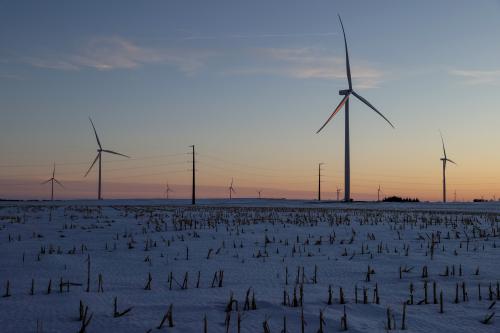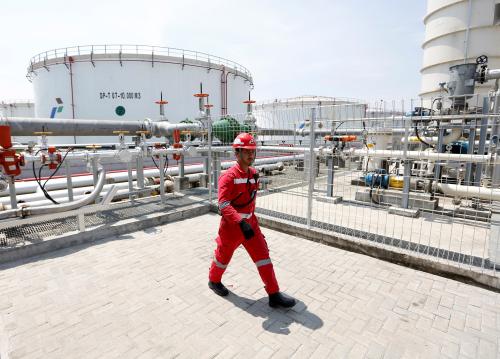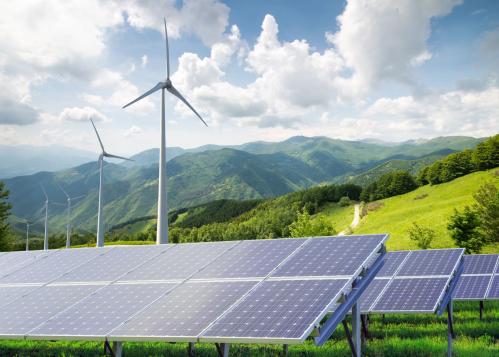The U.S. energy mix is changing. Renewables are ascendant in growth and continue to plummet in cost. Meanwhile, the struggles of fossil fuels were apparent even before the COVID-19 pandemic precipitated a dramatic drop in oil prices and hastened the collapse of coal. The result is a cleaner and cheaper U.S. power sector that is more responsive to market forces and technological advancement.
Electric utilities, with their integral role in power generation, are among the vanguard of stakeholders effecting this transition. By building out renewables portfolios, investing in emerging technologies, and retiring old and inefficient infrastructure, many utilities are helping to shift the United States to a more efficient and responsible energy grid while stimulating job growth and reducing electricity costs for consumers.
Some utilities, however, have resisted the prevailing technological and societal trends powering the modernization and decarbonization of the U.S. electrical grid. This resistance often comes in the form of keeping old and inefficient power plants online, despite financial incentives to embrace cleaner, more modern generation sources.
Because many of those older power plants operate at a loss, utilities taking this position often turn to local and state governments for subsidies or bailouts. While bailouts are not necessarily problematic in and of themselves, in some cases a shadowy constellation of individuals, organizations, and companies are the driving forces behind them. Such networks of actors often offer tendentious justifications for the bailouts they seek that downplay the negative financial and environmental consequences. They then take advantage of lax disclosure laws to conceal their involvement or their connections to the policymakers pushing to grant the bailout with public funds.
The recent corruption scandal surrounding the FirstEnergy electric utility and House Bill 6 (H.B. 6) in Ohio provides an example of the harm done to ratepayers and the energy transition when bad actors and dark money work together to conceal the true motivations behind utility bailouts.
H.B. 6, taken up in the Ohio House of Representatives in April 2019 and then signed into law by Ohio Gov. Mike DeWine three months later, is a sweeping, energy-focused bill opposed by an unlikely bipartisan mix of lawmakers, environmentalists, and free-market conservatives. Its provisions granted bailouts to two floundering nuclear power plants owned by FirstEnergy and two unprofitable coal-fired power plants owned by the Ohio Valley Electric Corporation. Those bailouts were to be paid for by surcharges on residential, commercial, and industrial electric bills totaling $170 million per year until 2027. Furthermore, H.B. 6 stipulated the reduction—after 2026—of the state’s decade-old clean-energy mandate and the weakening of energy efficiency standards for utilities.
The Ohio House passed H.B. 6 by a margin of 51-38 despite widespread—and bipartisan—state-level support for the embrace of renewables and increased energy efficiency. In a 2019 poll, two-thirds of conservatives surveyed by the Ohio Conservative Energy Forum expressed support for the diversification of the state’s energy mix toward renewables. Furthermore, Ohio ranks in the top 10 of states with the most jobs in clean energy—around 114,000 clean energy jobs total before the COVID-19 pandemic—and the rate of job growth in Ohio’s clean energy sector clocked in at 7.8% in 2019, the highest in the Midwest. These impressive statistics speak to Ohio’s recognized potential to attract massive in-state investment and turbocharge job growth in clean energy and manufacturing.
So, given popular appetite for cleaner energy, investment and job-growth potential, coupled with a world moving steadily and convincingly toward cleaner and more efficient power generation, why did Ohio legislators pass H.B. 6?
An FBI investigation concluded last summer that the inception, ensuing public campaign, and passage of H.B. 6 were marred by special interests and dark money.
Larry Householder, the Speaker of the Ohio House of Representatives, and several of his associates were arrested on racketeering charges in July of last year as part of the culmination of the FBI investigation into H.B. 6. The investigation found that Householder and allies took $61 million in bribes from FirstEnergy and other, primarily fossil-fuel interest groups. FirstEnergy deposited the bribes in the coffers of Generation Now, a 501(c)(4) nonprofit that, under federal law governing such “dark-money” groups, is not obligated to reveal the sources of its funding. The FBI complaint presented evidence indicating that Generation Now, though officially registered to an adviser of Householder’s, was controlled by Householder and his political associates. In exchange for the funds, which Householder and his counterparts used to finance everything from campaign ads to home renovations, FirstEnergy received in H.B. 6’s passage the nearly $1.5 billion bailout it had long sought.
H.B. 6 is likely to be repealed or replaced this year, given the corruption now exposed as central to its creation and passage. But the warning signs accompanying the bill’s fraught journey serve as hallmarks for activists, investigators, and transparency-committed policymakers to look for while lobbying against future utility bailouts.
The heavy involvement of Generation Now, a 501(c)(4) immune from public inspection of its contributors, was one such warning sign. In addition, FirstEnergy went bankrupt in 2018, at which point it unsuccessfully lobbied the Trump administration for a bailout. Householder had also been under investigation for a donations-for-legislation scheme during his first stint as House Speaker in the early 2000s. Context such as this is crucial for activists to broadcast to voters and consumers who can hold policymakers and utilities accountable.
Whatever the eventual fate of H.B. 6, the bailouts at the heart of its provisions were perhaps the clearest signal of its corrupt origins. Justifications for such bailouts often fly in the face of established fact—perhaps hinting at corruption as their driving force.
In Ohio and elsewhere, the case for rescuing energy infrastructure destined to lose out to cheaper and cleaner alternatives grows weaker with every passing day. National as well as global trends illustrate the rapid pace at which renewables are rendering fossil fuel and nuclear power plants unprofitable and obsolete.
Retiring old coal-fired and nuclear plants and sourcing electricity from renewables has been the cheapest way to generate power since as early as 2018. By substantial margins, ratepayers pay less for both subsidized and unsubsidized solar- and wind-generated electricity than that produced by coal, nuclear, and natural gas plants. As an example of the staggering pace of innovation in the energy sector, the cost of building a new solar photovoltaic plant has plummeted by 82% since 2010.
Furthermore, the growth of the renewable energy field means retiring old infrastructure in favor of cleaner alternatives revitalizes communities and creates sustainable jobs in a way obsolescing technologies cannot. Every $1 million invested in clean energy creates almost three times as many jobs than the same level of investment produces in the fossil fuel industry. Combined with jobs in energy efficiency, clean energy employs over 3 million Americans, compared to just over 1 million in fossil fuels. Forecasts predict that clean energy jobs will grow at a rate of 11 to 13 times that of the U.S. average as the sector expands.
Finally, recent national polling in the United States indicates that Americans are eager for government-led action on climate change. Seven in 10 Americans want the U.S. government to do more to combat the anthropogenic warming of the planet. In the same survey, two-thirds of those questioned expressed a desire for the United States to shift to a fully renewable grid.
With an incoming administration that has placed the energy transition and climate action at the forefront of its policy priorities, the calculus driving utility- and state-level decisions on energy infrastructure may fundamentally change. Increased federal investment in clean energy may further hasten the rise of renewables and the diminution of fossil fuels’ influence. Bailouts in the range of those granted by H.B. 6 may simply become too expensive to justify.
However, utilities and states will continue to reserve the right to make decisions regarding their energy portfolios, irrespective of the administration in Washington. Other utility bailouts have been passed since H.B. 6’s signing and more will follow, especially as market forces favoring decarbonization conflict with special interests aiming to keep inefficient and pollutive power plants online.
Around the time that H.B. 6 was making its way through the Ohio legislature, West Virginia awarded $12.5 million in tax breaks to a struggling, FirstEnergy-owned coal-fired power plant. Indiana passed a bill in March of last year—H.B. 1414—that institutes an artificial pause on coal-fired power plant shutdowns. And, in a new, worrying example, an NPR investigation found that the state of Wyoming uses the same dark-money laws used by FirstEnergy and the criminally charged legislators in Ohio to lobby against the closure of coal-fired power plants in other states.
As long as the laws surrounding 501(c)(4) nonprofits facilitate dark-money transactions, some utility bailouts will continue to be as opaque and regressive as bad actors believe they can get away with. Under those circumstances, suspicions or the reality of corruption will continue to factor in.
However, this corruption is neither inevitable nor unrecognizable. As previous research by the Leveraging Transparency to Reduce Corruption initiative has shown, a bundled approach of transparency, accountability, and participation mechanisms, coupled with close attention to contextual factors, can work to reduce corruption in natural resource governance. As applied to utilities, watchdogs and transparency-minded policymakers can recognize the unambiguous trends driving the evolution of the energy sector, heed past examples of corrupt behavior, and remain on the watch for signals of wrongdoing. Such activities can help to ensure that voters understand the questionable circumstances around some utility bailouts and that law enforcement authorities take notice. In doing so, they can preempt the negative consequences such corrupt transactions have on people and planet alike.






Commentary
Corruption in utility bailouts hurts ratepayers and the planet
February 2, 2021